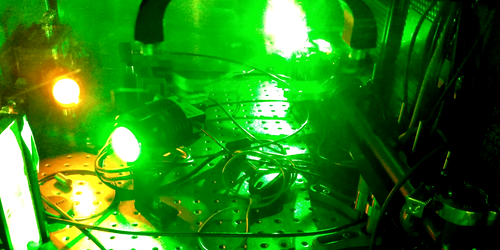A Salt-Based Laser Color Converter
High-energy, short-pulse laser sources exist only in a limited number of colors. Researchers in the 1960s found that a liquid-filled cell, which had inadvertently been placed inside a laser’s cavity, shifted the laser’s wavelength. Now a team of scientists from Brookhaven National Laboratory (BNL), New York, show that synthetic, room-temperature liquid salts can also serve as effective laser-color-tuning media [1]. The finding could lead to a simple and energy-efficient tool for creating lasers with desired colors for medical and scientific applications.
In the 1960’s liquid technique, when a photon “hits” a liquid molecule, the photon loses energy, exiting the medium with less energy—and thus a different color—than it entered (see Focus: Holey Fibers Shed New Light). The BNL team reasoned that a liquid salt could interact with photons in the same way while offering a high density of energy-swapping sites compared to either a gas or a standard liquid. The vast array of available artificial salts could also make it possible to precisely tune the energy loss caused by the salt–photon interaction, giving increased color control.
The researchers assembled their converter setup from a pulsed green laser and a 63-cm-long cell filled with a liquid salt. Passing the laser through the cell, they observed that the light turned orange. The researchers measured a high color-conversion efficiency of the photons, which they attribute to the large interaction cross sections of the salt molecules and to the reduction of other forms of scattering that can inhibit wavelength conversion. The group is currently designing liquids to turn this and other lasers to myriad colors.
Correction (20 January 2023): A previous version of the text inaccurately called the “liquid salt” a “salt solution.”
–Rachel Berkowitz
Rachel Berkowitz is a Corresponding Editor for Physics Magazine based in Vancouver, Canada.
References
- R. Kupfer et al., “Raman wavelength conversion in ionic liquids,” Phys. Rev. Appl. 19, 014052 (2023).




